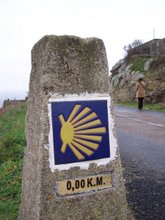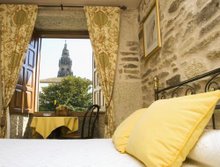 One of the biggest sacrifices you can make is to adjust your rhythm and habits to accommodate someone else’s. And one of the most profound luxuries in life is to move through the world at exactly your own pace.
One of the biggest sacrifices you can make is to adjust your rhythm and habits to accommodate someone else’s. And one of the most profound luxuries in life is to move through the world at exactly your own pace.Of course society would crumble if we didn’t adapt ourselves left and right—to the needs of family, lovers, and friends; to the flow of traffic; to a work schedule.
But every now and then you’ve got to let yourself move to nothing more or less than your internal beat--the particular rhythm of your own heart and mind--if only to remember that it does indeed exist, under all the shifts and syncopations life imposes.
I walked the Camino de Santiago alone, and I’m very glad I did.
I thought I’d be one of few, but I wasn’t. I’d estimate that twenty to thirty percent of pilgrims were walking alone, most because they wanted it that way, a few because companions had pulled out at the last minute. And even most of those in the latter category had come to see the change in plans as a blessing in disguise.
But first, a disclaimer: I like to travel alone. I also like to travel with others. But for something as personal as a pilgrimage, going it alone seems the best way to ensure that the trip doesn’t slip into tourist mode or that you miss half of what there is to see and feel along the way.
I saw many pairs on the Camino, walking along deep in conversation about things back home (a spouse, a child, a job). Sure it’s great to talk with old friends, but you can do that at a café near your house. Why travel so far, lugging all you need on your back, walking a route that people have walked for over 1000 years, just to talk to a friend you can talk to back home?
Don’t waste the walk on idle talk. Keep quiet, look around, and see what it feels like to move through the world alone. Which is (not to be morbid) fundamentally the way we all walk through this world.
Many people confuse being alone with being lonely. But I felt more lonely among crowds of chattering friends of friends in Rome than I ever felt walking solo on the camino. Walking, you’ll have a community of like-minded pilgrims with whom to strike up a conversation. If you want company, you’ll have it. And if you don’t, your desire to keep to yourself will be respected. This is a pilgrimage, not a high school reunion.
If you’re concerned about safety, don’t worry. I started the walk wearing one of those around-the-neck pouches that hold all your cash and documents. Two or three days in, the pouch felt hot and bulky and the left shoulder strap of my pack had dug the cord of the pouch into my shoulder, rubbing it raw. I moved the pouch to the map pocket of my pack and never looked back, literally or figuratively.
I wasn’t completely trusting. In cities I wore the neck pouch. And when staying in a hostal, I would take that pouch with me when I left my pack in the communal bunkhouse. But other than those minor precautions I really didn’t worry about security—for my possessions or for my person. My fellow pilgrims were never anything but decent and helpful.
If you’re thinking of walking alone but are wavering, I offer hearty encouragement for you to go for it. Walk it alone, at your own pace, and you’ll really feel and see the camino.






